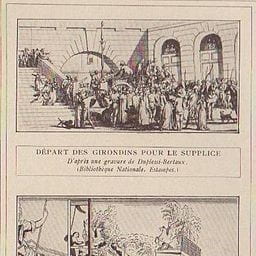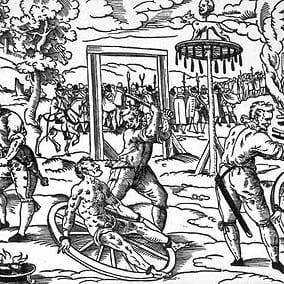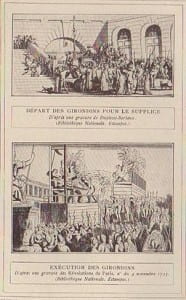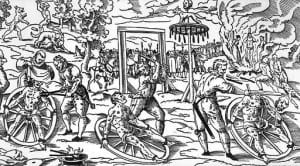Throughout history, violence has been a huge factor in deciding how people react in wars and revolutions. In the French and Haitian revolutions, violence was both very savage and gruesome. Both revolutions used many different types of violence which, in a way, helped shape the way both revolutions progressed through the years. The French and Haitian revolutions were, in some ways, similar with the forms violence used but also different in others.
Violence in the French revolution was used by the many different leaders to control and suppress the counter revolutionaries, royalists, and anyone deemed suspicious and to insert fear in the people’s hearts. The types of violence were also used by the citizens to fight the oppression being imposed upon them by the government. Violence was used by both sides to achieve the goals that each of these set for themselves. The types of violence committed in the French revolution went from over the top savagery to organized, institutionalized, and (presumably) painless.
The first type of violence seen in the French revolution was popular violence, which was seen through the spectacle of mutilation. The people would form mass riots and hang their victims from the lamp posts. After they were dead, the people would then chop off their heads and stick it on the pike along with the victim’s organs. The body would then be paraded around the city for all to see (Fehaer, 159-160). The victims of this particular type of violence were usually people in the clergy or higher positions in society and were often the most despised individuals by the populace.
September Massacres
The second type of violence used in the French revolution was seen in the September massacre of 1792. The September Massacre was premeditated and took place because of a rumor stating that the counter revolutionaries in the prison were planning an uprising. In order to stop this uprising the revolutionaries took up arms and stormed the prison massacring all the prisoners inside who were defenseless and cornered. It was estimated that 1,400 people lost their lives that day and it has been stated that many of these citizens were innocent people (Fehaer, 157-159).
Gironde guillotine French Revolution 1793 Famille Le Clerc
Another type of violence that took place is, also the most popular type of violence which was seen in the French revolution, the utilization of the guillotine. Before the guillotine, executioners would have to use axes and swords to behead the criminals, which left room for human error. Joseph Guillotin created the guillotine to enact instantaneous death upon its victims. All the executioner would have to do is pull the cord and a sharp blade would drop on the victim’s neck and behead them. It was considered a more humane way to execute victims, and was used mostly by decree of Robespierre and other government officials.
In the Haitian revolution, violence was much more gruesome and medieval than the French revolution. In fact, it has been argued by some historians that the atrocities committed by the French towards the Haitians in the years of 1802 and 1803 were an attempted genocide. However, it also has been argued that the atrocities actually have not met the “modern-day standards for genocide” (Girard, pg. 133). It is difficult to assess whether the atrocities committed by the French are considered to be an attempted genocide because not all of the atrocities committed coincide with the definition of the 1948 United Nations Convention on the Prevention and Punishment of the Crime of Genocide. For instance, the 1948 convention’s article 3 on the responsibility, claims that anything from conspiring to commit genocide to actually attempting to commit it is considered a crime and inhumane. However, Napoleon never once conspires or enacts orders from France to eradicate the gens de couleur or the insurgents (Girard, pg. 145).
Another example on how it is difficult to assess genocide in the Haitian revolution is seen in the 1948 convention’s article 2, which is about the extermination of a whole or part of a certain racial group. Due to all the deaths of the gens de couleur and insurgents it is almost impossible to see how many gens de couleur and insurgents were out right massacred by the French or just died in combat fighting for or against the French (Girard, pg. 145-146). Also, even though Leclerc and Rochambeau wrote about the “war of extermination against ‘negroes,’” (Girard, pg. 146) it was actually directed at the rebels as a whole and not at a direct race in general (Girard, pg. 133). The term “Negroes” back in the 1800’s was more of a “generic descriptor for groups that happened to be black but whose primary characteristic was social (such as maroons, rebel cultivators, or the colonial army)” (Girard, pg.146). In the end, Leclerc and Rochambeau may not have expected that by eradicating the enemies they were committing genocide (Girard, pg.146). Overall, it is very difficult to even attempt to try and define this revolution as an attempted genocide because it does not fit the definition of genocide today.
The types of violence seen in the Haitian revolution were a chain reaction based off of how the masters treated their slaves. The first type of violence was seen through the treatment of the slaves. The slaves were treated very cruelly, in some cases, by their slave owners. Some, especially women, were placed in iron collars with spikes if they misbehaved, or if their masters found out that these women had given themselves an abortion they would be severely punished (Geggus, Doc.4). Masters would also whip their slaves to keep them in line, or use whips to punish individuals for going against the masters wishes. Other masters would burn their slaves, torture them, or even murder them, if they didn’t do what they were told (Geggus, Doc. 5). Some were sadistic enough to cut off limbs of their slaves or bury them in the ground up to their necks. (Dubois, pg. 21) These forms of violence led to the slaves practicing their own forms of violence against their masters. Some slaves would dabble with the art of utilizing poison. They would use poison to either poison their masters, their master’s livestock, or even themselves (Geggus, Doc. 12). Other forms of violence the slaves committed was during the insurrection. The slaves burned down their master’s plantations, mutilated their masters and/or killed them, female slaves would often take revenge on their male masters and beat them to death for all the sexual deeds they forced the female slaves to do (Popkin, chapter 2).
Gallows. 1930 painting by Felix Nussbaum
In the year 1802, the bloodiest portion of the Haitian revolution began after Napoleon’s brother-in-law, General Charles Leclerc, got orders to sail to Saint-Domingue and crush the insurgents. The French troops under Leclerc took revenge on the gens de couleur and the insurgents for the deaths of the French soldiers and civilians by shooting them or putting them under the sword. Also under Leclerc’s command, any cultivators found with weapons were shot by firing squad or hung at the gallows (Girard, pg. 137). Starting in August 1802, under Leclerc and his successor Rochambeau mass executions started to take place. According to Dubois Leclerc and Rochambeau, began mass executing through the means of “dumping them into the harbor with weights on their necks… also gass[ing] prisoners, locking them up in the holds of ships and asphyxiating them with burning Sulphur” (Dubois, pg. 40). The mass drownings and asphyxiations of the prisoners began in September 1802 under Leclerc because he believed it was the only way to exterminate the opposition. Both of these forms of violence were discreet and efficient (Girard, pg. 139). After his death, Leclerc’s successor, Rochambeau continued with these mass exterminations.
Under Rochambeau new types of violence emerged. Rochambeau used a couple different forms/types of violence ranging from crucifixion to being devoured by hounds. The instances of Crucifixions, however, revealed that only one eye witness account was found from this time period, the other accounts were found in the later centuries (Girard, pg. 142). Crucifixion was used on prisoners and Rochambeau’s rivals. The victims were nailed to a cross like fixture and nails were put through their hands and feet. Rochambeau also burned his victims at the stake as well as using dogs to sniff out the insurgents in the woods and mountains. He then would take the prisoners and put them in a make shift arena and sic the dogs on them and watch them be devoured alive (Girard, pg. 143).
Atrocities committed by the Haitians were just as horrific as the atrocities committed by the French. In 1804, Dessalines told the Haitian people to enact revenge on the whites for the crimes committed against their people. Dessalines’ troops massacred the French troops and civilians out of revenge (Girard, pg. 144). On one occasion, Dessalines took the French prisoners and hung them on a hill in plain sight of the French army (Geggus, Doc 79).
Execution of Peter Stumpp in Cologne in 1589 on the Breaking Wheel.
Some types of violence were used in both the French and Haitian revolutions. One type of violence used was called the breaking wheel. In France, the victims were usually criminals or counter revolutionaries, but in the Haitian revolution they were prisoners of war who would be sent to France where they would be judged. If they were found guilty, they would either be sent to the guillotine or the breaking wheel. The breaking wheel was a much worse fate than the guillotine. The guillotine was a quick and painless execution while the breaking wheel was a long and painful one. The victim’s limbs would be tied to the spokes on a giant wooden wheel. The executioner would then spin the wheel and use an iron hammer to smash their bones and then leave them there to die of dehydration which could take upwards of 2-3 days. The executioner at times would also just end it quickly by smashing their major organs with the hammer causing a swifter death (Sierra, Medieval Torture).
Lynching was another type of violence used in both the French and Haitian revolutions. In France, victims were generally criminals or counter revolutionaries, while Haitian victims were gens de couleur, insurgents, and the occasional whites who sided against the French army. The victims were hung from gallows, trees, and lampposts (Girard, 138).
In conclusion, the forms/types of Violence in both revolutions were horrific and devastating to the members of both the population and the opposing sides. Both revolutions shared some similarities and differences with types of violence used. The Haitian revolution was much more violent than the French and . These two revolutions both shaped the way the country looks and left deep scars on both societies.
[poll id=”6″]
[poll id=”7″]
Question to Consider:
Shootings and hangings were the original form of punishment. Why do you think the punishment got more gruesome over time in the Haitian Revolution, but more organized during the French Revolution?







